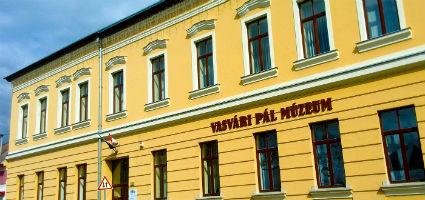2026. January 1. Thursday
András Jósa Museum - Pál Vasváril Museum - Tiszavasvári
 |
Address: 4440, Tiszavasvári Kálvin u. 7.
Phone number: (42) 911-013
E-mail: info@vasvaripalmuzeum.hu
Opening hours: 01.04-30.09.: Tue-Sun 9-17
01.10-31.03.: Tue-Sun 8-16 |
Museum tickets, service costs:
|
Ticket for adults
|
400 HUF
|
|
|
Ticket for students
|
200 HUF
|
|
|
Ticket for pensioners
|
200 HUF
|
Post-glacial warming up allowed the cultivation of plants and animal husbandary in the flat territories of the Carpathian Basin, as well. Nyíri Mezőség, which lies between Hortobágy, Nyírség and the eastern bank of the river Tisza, is one of the few regions that provide a wide range of excavated settlements and cemeteries from 5,000 B.C. up to the Middle Ages representing the development of the consecutive civilizations.
The earliest relics belong to the Neolithic Tiszadob group. The Atlantic autochthonous population of the area emerged on the mounds alongside the Tisza, in a climatic zonal borderland under Central European and Mediterranean influences. Keeping similar domesticated animals and growing similar species of plants, various populations had been living here almost unceasingly until a new, pastoral group of people appeared around 2,500 B.C. This may have taken place at the end of the Copper Age and at the beginning of the early Bronze Age, when the selection advantage of the populations which were able to adapt themselves to the newer climatic changes prevailed.
At about 1,900 B.C., this territory was occupied by groups of people who were familiar with the craft of bronze-casting. Their weapons and treasures hidden in the ground owing to their struggles for power were excavated by archaeologists.
The use of iron, the new metal was introduced here by the Scythians and the Celts some time in the 9th or 8th century B.C. After 400 B.C. the Celts already used ploughs with ironed parts and mills with runners, moreover, they applied glassware and potter’s wheels, which all contributed to a change in lifestyle.
In the 1st century A.D., the eastern part of the Great Plain became inhabited by the Sarmatians, who lived here for about four hundred years. The remains of their tribes are also known from the Hun period (5th century A.D.).
From the second part of the 5th century the authority of the Gepids was felt in the Great Plain. It is strange that relatively a small number of archaeological finds refer to their prevalence in nyíri Mezőség.
However, all the more findings belong to the Avar era, which lasted from 568 to 895, and the early phase of which (up to 670) can be characterised by Iranian and Central Asian parallels according to the skeletons excavated. Human burials with horses, which have been reconstructed, and an imported Byzantine amphora also date back to this period. The immigrant population after 670 came in here partly from Central Asia partly from the Volga area.
In 895, the Hungarian conquerors settled down in this region. Out of their numerous cemeteries, primarily the finds dug up from the graves of the armed attendants of the generic aristocracy rendered help to reconstructing and displaying both male and female wear of the age.
The earliest relics belong to the Neolithic Tiszadob group. The Atlantic autochthonous population of the area emerged on the mounds alongside the Tisza, in a climatic zonal borderland under Central European and Mediterranean influences. Keeping similar domesticated animals and growing similar species of plants, various populations had been living here almost unceasingly until a new, pastoral group of people appeared around 2,500 B.C. This may have taken place at the end of the Copper Age and at the beginning of the early Bronze Age, when the selection advantage of the populations which were able to adapt themselves to the newer climatic changes prevailed.
At about 1,900 B.C., this territory was occupied by groups of people who were familiar with the craft of bronze-casting. Their weapons and treasures hidden in the ground owing to their struggles for power were excavated by archaeologists.
The use of iron, the new metal was introduced here by the Scythians and the Celts some time in the 9th or 8th century B.C. After 400 B.C. the Celts already used ploughs with ironed parts and mills with runners, moreover, they applied glassware and potter’s wheels, which all contributed to a change in lifestyle.
In the 1st century A.D., the eastern part of the Great Plain became inhabited by the Sarmatians, who lived here for about four hundred years. The remains of their tribes are also known from the Hun period (5th century A.D.).
From the second part of the 5th century the authority of the Gepids was felt in the Great Plain. It is strange that relatively a small number of archaeological finds refer to their prevalence in nyíri Mezőség.
However, all the more findings belong to the Avar era, which lasted from 568 to 895, and the early phase of which (up to 670) can be characterised by Iranian and Central Asian parallels according to the skeletons excavated. Human burials with horses, which have been reconstructed, and an imported Byzantine amphora also date back to this period. The immigrant population after 670 came in here partly from Central Asia partly from the Volga area.
In 895, the Hungarian conquerors settled down in this region. Out of their numerous cemeteries, primarily the finds dug up from the graves of the armed attendants of the generic aristocracy rendered help to reconstructing and displaying both male and female wear of the age.
|
Related activities
|
|||